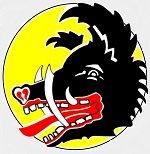Corgi AA27107 German Messerschmitt Bf 109G-6 "Gustav" Fighter - "Red 8", Kurt Gabler, "Mosquito Hunter", III./Jagdgeschwader 300, Juterbog-Waldlager, Germany, July 1944 (1:72 Scale)
"We did not think about the personal nature of killing in the air. We were proud of every victory in the air, and particularly happy that we had not been hit ourselves. Of course, I tell myself in quiet moments today: 'You've killed. In order to protect others and not be killed yourself.' But in the end: for what? The Third Reich trained 30,000 pilots. Ten thousand survived the war. One-third. This is the highest loss rate along with the U-boat sailors."
- Oberleutnant Gunther Rall
 Numerically the most abundant fighter produced by either side during WWII, the Messerschmitt Bf 109 formed the backbone of the Jagdwaffe on both the eastern and western fronts, as well as in the Mediterranean and North Africa. Of the eight distinct sub-types within the huge Bf 109 family, the most populous was the G-model, of which over 30,000 were built between 1941-45. Despite its production run, only a handful of genuine German Bf 109s have survived into the 1990s, and with the serious damaging of the RAFs G-2 at Duxford in October 1997, only the German-based MBB G-6 and Hans Ditte's G-10 (both composites) are currently airworthy.
Numerically the most abundant fighter produced by either side during WWII, the Messerschmitt Bf 109 formed the backbone of the Jagdwaffe on both the eastern and western fronts, as well as in the Mediterranean and North Africa. Of the eight distinct sub-types within the huge Bf 109 family, the most populous was the G-model, of which over 30,000 were built between 1941-45. Despite its production run, only a handful of genuine German Bf 109s have survived into the 1990s, and with the serious damaging of the RAFs G-2 at Duxford in October 1997, only the German-based MBB G-6 and Hans Ditte's G-10 (both composites) are currently airworthy.
The Bf 109 G-series was developed from the largely identical F-series airframe, although there were detail differences. Modifications included a reinforced wing structure, an internal bullet-proof windscreen, the use of heavier, welded framing for the cockpit transparencies, and additional light-alloy armor for the fuel tank. It was originally intended that the wheel wells would incorporate small doors to cover the outer portion of the wheels when retracted. To incorporate these the outer wheel bays were squared off. Two small inlet scoops for additional cooling of the spark plugs were added on both sides of the forward engine cowlings. A less obvious difference was the omission of the boundary layer bypass outlets, which had been a feature of the F-series, on the upper radiator flaps.
Like most German aircraft produced in World War II, the Bf 109 G-series was designed to adapt to different operational tasks with greater versatility; larger modifications to fulfill a specific mission task, such as long-range reconnaissance or long-range fighter-bomber, were with "Ruststand" and given a "/R" suffix, smaller modifications on the production line or during overhaul, such as equipment changes, were made with kits of pre-packaged parts known as Umrust-Bausatze, usually contracted to Umbau and given a "/U" suffix. Field kits known as Rustsatze were also available but those did not change the aircraft designation. Special high-altitude interceptors with GM-1 nitrous oxide injection high-altitude boost and pressurized cockpits were also produced.
Pictured here is a 1:72 scale replica of a German Messerschmitt Bf 109G-2 "Gustav" fighter that was flown by Kurt Gabler, nicknamed the "Mosquito Hunter", and attached to III./Jagdgeschwader 300, then deployed to Juterbog-Waldlager, Germany, during July 1944.
Sold Out!
Dimensions:
Wingspan: 5-1/2-inches
Length: 5-inches
Release Date: August 2018
 Historical Account: "Gustav" - The Messerschmitt Bf 109 series of fighters were produced in greater numbers than any other fighter aircraft in history and saw service throughout the entire Second World War. The final K-4 version was the fastest of the Daimler Benz powered 109s, capable of speeds in excess of 440mph, compared to the 330mph of the Battle of Britain era 'Emil'. Constantly developed and upgraded, the sleek and cultured late war machines bore little resemblance to the angular fighters that swept across Europe in the early months of WWII, despite the basic airframe remaining almost identical.
Historical Account: "Gustav" - The Messerschmitt Bf 109 series of fighters were produced in greater numbers than any other fighter aircraft in history and saw service throughout the entire Second World War. The final K-4 version was the fastest of the Daimler Benz powered 109s, capable of speeds in excess of 440mph, compared to the 330mph of the Battle of Britain era 'Emil'. Constantly developed and upgraded, the sleek and cultured late war machines bore little resemblance to the angular fighters that swept across Europe in the early months of WWII, despite the basic airframe remaining almost identical.
Contrary to common misconception, the Messerschmitt remained an extremely competent fighter aircraft throughout WWII and in the hands of an experienced pilot was more than capable of challenging the very latest Allied designs. Unfortunately, by the later stages of WWII, the Luftwaffe was simply unable to call on the services of experienced fighter pilots and was running out of new aircraft, spares and fuel. Despite this, history will note that some of the world's most edition successful air aces used the Bf 109 to gain many of their victories.
"Red 8" was a Bf 109G-6 flown by Oblt. Kurt Gabler, III./JG300, in July 1944. From photographs this aircraft appears to have been sanded back from its original RLM74/75/76 finish, reportedly in an effort to increase its speed for intercepting RAF Mosquitos. Traces of paint are visible on the wing root and base of the elevators, and the swastika has clearly been sanded down, leaving only a faint trace. Note that the gun troughs and various access panels appear darker than the rest of the aircraft because they are composed of darker metals (e.g., the gun troughs were iron). This same effect is seen in photographs of a sanded down Bf109G belonging to the National Air and Space Museum (NASM), adding support to the claim that "Red 8" was natural metal rather than light grey.





 Messerschmitt
Messerschmitt 


